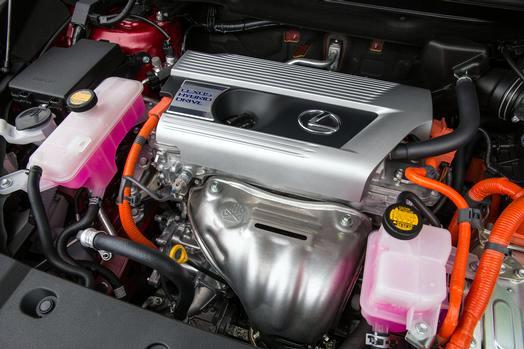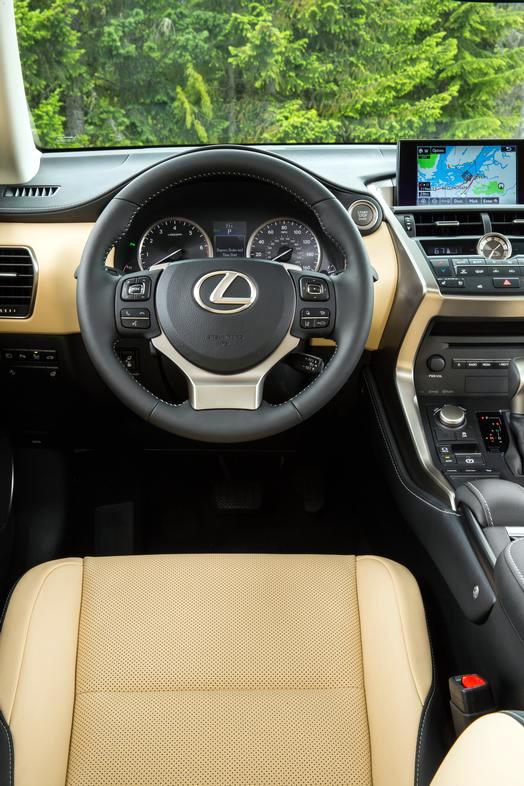Crossover Electric Efficiency
The 2018 Lexus NX 300h brings Toyota’s famous hybrid technology to a compact crossover shape. That’s good for about a 25 percent improvement in fuel economy and substantially improved emissions compared the standard NX 300, in a luxurious package.

The secret to any hybrid is that it uses less fuel because it’s running electrically part of the time. In this case, instead of the NX 300’s 275-horsepower 2.0-liter turbocharged four-cylinder, the NX 300h gets a non-turbo 2.5 liter four, with just 154 horsepower (152 pounds-feet of torque). However, it’s the addition of three electric motor generators and a 204-cell nickel metal hydride battery that make the difference. This car has no plug, so all electric energy is generated by regeneration when braking and from the internal combustion engine.
The three motor generators have different locations and functions. One, up front, serves as the engine’s generator and starter and charges the hybrid battery. A second front-mounted unit drives the front wheels and regenerates energy during braking. The third motor generator lives in the rear and also regenerates electricity, as well as allowing “all-weather-drive.”

Combined, the system puts out 194 horsepower, which is significantly less than the NX 300, but still enough to move the two-ton machine down the road respectably. Interestingly, the all-wheel-drive 300 and the 300h weigh within 30 pounds of each other.
Interaction between the drivetrain components is invisible to the driver. Because electric motors have torque from the moment they engage, there’s no hesitation when you start out. Sometimes, that means silent of EV motoring, but when the engine kicks in, you just keep on going.
The Numbers Game
The 2018 Lexus NX 300h pulls in EPA mileage figures of 33 city/30 highway/31 combined. Compare this to the gas-only NX 300’s 22 city/28 highway/24 combined respectively and you see a nice improvement. Naturally, if you drive primarily in slower suburban situations, you may be able to get more regeneration and shift the electric/gasoline ratio for better numbers. I averaged 29.0 mpg in a week of mostly freeway commuting (a mix of 70 mph cruising and crawling).
EPA Green numbers tell another happy tale. The NX 300h receives a pair of lucky 7’s for Smog and Greenhouse Gas, while the NX 300 earns a 3 and a 5 respectively. Emissions are 283 grams of CO2 per mile for the hybrid vs. 363 for the gas-only model.
The Lexus Look
Numbers aside, the NX is a typical Lexus, with bold, slashing designs in the sheet metal and a luxuriously appointed interior. The huge grill has become a Lexus hallmark, even if it still looks a bit frightening. The sides are aggressively sculpted to match. Although this is the smallest Lexus crossover (for now), it fits right in with its larger sibling, the popular RX. It fits right in on the sales charts, too, as Lexus’ number seller behind the RX.

Inside, the design features layered surfaces and materials. A “blade” of wood trim pops out in a few spots, keeping your eye moving. The edginess continues onto the steering wheel, where beveled edges make the buttons easy to find. The user experience is heavy on buttons and lights, so at night you may feel a bit like a pilot.
The comfy seats provide that above-the-fray crossover feeling that today’s buyers covet. Commuting is pleasant, and I expect that longer road trips would be as well.
Luxury Upgrades
As a luxury model, you expect the NX to deliver certain features. However, my test car contained some significant upgrades, which drove the price up substantially. The base price, not including delivery, started at $38,335, but the final sticker for my Atomic Silver test car came to $49,770. How did we get there?
Nearly half of the upgrade came from the Luxury Package ($4,705), with 18-inch alloy wheels, fancier wood trim, heated and cooled leather front seats, rain-sensing wipers, a moonroof, blind-spot monitor with cross-traffic alert and more. My car also came with the Navigation Package ($1,800), panoramic-view backup monitor ($800), Intuitive Parking Assist ($535), power rear liftgate ($400), power folding rear seats ($400) and a towing package ($160). It makes me wonder if a vehicle without these things would deliver the same experience.

I had a few nitpicks. The left front wheel well intrudes above the dead pedal. The heated steering wheel only heats in the 3 and 9 areas, so when you’re turning it on a cold morning it’s a little disconcerting. But otherwise the NX provides a very pleasant experience, and with its commodious rear cargo area, serves as a perfect hauler as well.
Lexus offers seven hybrids, including four sedans, a coupe and the NX and RX crossovers. Each features a proven, highly developed system that can save you money and lower your carbon footprint incrementally. The brand doesn’t offer a pure electric vehicle yet, but this model would be a great place to start.
Related Stories You Might Enjoy—Other Lexus Hybrids/Other Luxury Crossover Contenders
News: 2019 Lexus ES 300h Hybrid Breaks Cover
Road Test: 2018 Lexus LC 500h
News: Lexus UX Subcompact Crossover Debuts
Road Test: 2018 Lexus GS 450h
Road Test: 2018 GMC Terrain Denali
News: Subaru Crosstrek Plug-in Hybrid To Arrive
News: Buick’s Electric Car Explosion
News: BMW iX3 Crossover Comes to US in 2020
News: SF Motors Enters Electric Car Market
News: 2019 Jaguar I-Pace Electric SV Revealed
Flash Drive: 2019 Infiniti QX50
News: Byton Introduces Electric SUV
Disclosure:
Clean Fleet Report is loaned free test vehicles from automakers to evaluate, typically for a week at a time. Our road tests are based on this one-week drive of a new vehicle. Because of this we don’t address issues such as long-term reliability or total cost of ownership. In addition, we are often invited to manufacturer events highlighting new vehicles or technology. As part of these events we may be offered free transportation, lodging or meals. We do our best to present our unvarnished evaluations of vehicles and news irrespective of these inducements.
Our focus is on vehicles that offer the best fuel economy in their class, which leads us to emphasize electric cars, plug-in hybrids, hybrids and diesels. We also feature those efficient gas-powered vehicles that are among the top mpg vehicles in their class. In addition, we aim to offer reviews and news on advanced technology and the alternative fuel vehicle market. We welcome any feedback from vehicle owners and are dedicated to providing a forum for alternative viewpoints. Please let us know your views at publisher@cleanfleetreport.com.

1 thought on “Road Test: 2018 Lexus NX 300h”